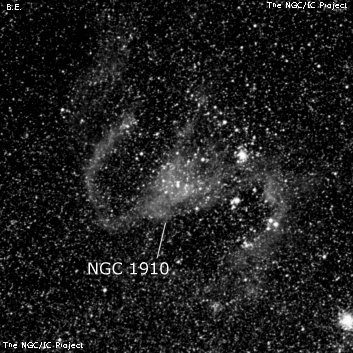
The cluster is embedded in LMC-N119, a very large, bright emission nebula. The most prominent section of the nebula is a very bright 3' patch to the east of S-L 360 and a wing to the south of S-L 360 that responds well to a UHC filter at 200x. Nebulosity is also visible on the west side of S Doradus. This section curves N-S to S-L 360 and also south of S Doradus. To the south of NGC 1910, on a northwest to southeast stream extending a couple of degrees, are dozens of LMC clusters with NGC 1903, an impressive globular, situated 10' SW. In a 1953 paper, Harlow Shapley and Virginia Nail defined NGC 1910 as the center of "Constellation V", a 24' region containing numerous blue supergiants.
James Dunlop discovered NGC 1910 = D129 = h2827 on 3 Aug 1826 with his 9" reflector from Parramatta, New South Wales. He described "A pretty large and very ill-defined nebula, of an irregular round figure, with several small stars in it." His position is unusually accurate.
John Herschel first recorded it in Dec 1834 as a "fine cluster. Irregular figure, the chief nucleus (which seems to be a close double star, 9th mag) taken." On a second sweep he called it "The most condensed knot ( = 12 arcseconds) in a pretty rich, L, scattered cluster." His third observation was recorded as "p rich L cluster 10' diameter. It has in it a close triple star, easily taken for a nebulous knot. (N.B. This is doubtless the knot taken in the three foregoing observations...)."
600/800mm - 24" (4/5/08 - Magellan Observatory, Australia): this large, bright cluster or star cloud (stellar association LH 41) contains the variable star S Doradus (8.6-11.5), the brightest star in the LMC and one of the brightest known stars (absolute magnitude -9). At 200x, roughly 100 stars mag 11-15 were resolved in a 7' region with some extensions increasing the diameter another couple of arc minutes. S Doradus is the brightest star in the main portion of the cluster, though there are several other mag 11 and 12 stars. S-L 360 is on the NW side (2' N of S Dor) and appeared as a small bright knot that was clearly non-stellar and surrounded by a thin, fainter halo (ring of faint stars on DSS). HDE 269333, a mag 11.2 Wolf-Rayet binary (WN+B) lies 1.6' NNE of S-L 360.
Notes by Steve Gottlieb